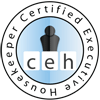De-scalers are products that remove mineral-scale buildup from sinks, showers, tubs, and toilets. Mineral scale is a problem for people who live in regions with hard water, but it can cause concern in other areas as well. Since rust deposits often come from well water, we include them in the discussion.
Following is a list of acids, from mild to strong. The strongest acids should be avoided since they may also damage metals, such as the chrome used in many plumbing fixtures. Regardless of what you use, be sure to read and follow all product label directions, cautions and warnings. Use plenty of clean water to rinse the surface when you’re done.
• Acetic acid: This weak acid, commonly found in vinegar, derives its name from the Latin for vinegar, acetum. This 4 to 8-percent solution (white vinegar) of acetic acid will work on many scale deposits if allowed to remain in contact for up to 30 minutes. Soak a cloth or paper towel in white vinegar and lay it over the deposit.
• Phosphoric acid: This acid is good for removing mineral scale and rust stains from surfaces. It is stronger than acetic, but not as strong as hydrochloric acid (of course, acid strength depends on the amount of dilution).
• Commercial preparations: Manufacturers combine acids, frequently citric or hydrochloric, with other chemicals to form household de-scaling aids. C-L-R and Lime A Way are familiar names in this category.
• Hydrochloric acid: Commonly called muriatic acid, this well-known lime scale remover is available in concentrations as high as 25 percent for commercial use in toilet bowls. It is highly effective, but is corrosive on chrome and other metals, and will dissolve nylon. Its strong, acrid fumes make adequate ventilation a prime concern. Its use is best left to professionals.
• Oxalic acid: Often used as a rust remover, this is a last-resort de-scaler because of its strength and toxicity. Wear latex gloves, long sleeves, and eye protection if you must use a product containing oxalic acid, and make sure the area is well ventilated.
• Hydrofluoric acid: Strong enough to etch glass in industrial applications, this dangerous acid (HF) sometimes finds its way into the home in rust removers. Honeywell, the world’s foremost supplier of HF, recommends that it not be used in consumer products due to the highly corrosive nature of the acid and its fumes, and the fact that it will readily penetrate the skin to cause destruction of the deep tissue layers, attacking the calcium in the affected area. While strong concentrations cause immediate, severe pain upon exposure, more dilute concentrations (such as found in rust removers) may take days before symptoms are noticed. The acid is difficult to neutralize, possibly requiring injections of calcium. Our best advice is that of the manufacturer: Avoid exposure. Never allow any product containing HF to remain in your home.









